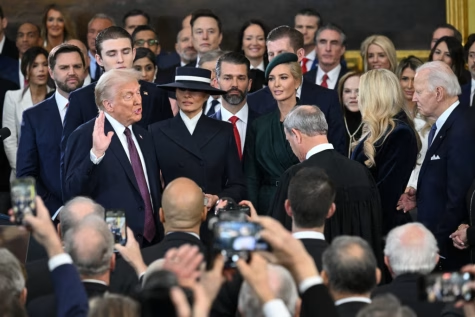In a blunt speech brimming with ambition and promises, Donald J. Trump was sworn into office for a second term in Washington, D.C., on January 20, 2025. The address, delivered on Martin Luther King Jr. Day, was laden with pledges to restore America’s global stature, address domestic crises, and reverse what he described as years of betrayal by the “corrupt establishment.”
The New White House Page erupts in celebration:
After being sworn in, President Trump opened his speech with gratitude, addressing a lineup of dignitaries, including Vice President Vance, Speaker Johnson, and former Presidents from Clinton to Biden. He declared, “The Golden Age of America begins right now,” setting a tone of optimism and resolve.
Watch:
Central to his speech was the promise to put “America first,” with a focus on reclaiming sovereignty, restoring safety, and rebalancing justice. He criticized the previous administration’s handling of national issues, from border control to emergency responses like those for hurricanes and wildfires. “We have a government that cannot manage even a simple crisis at home,” Trump stated, highlighting recent natural disasters where he claimed the response was inadequate.
Trump’s speech was rife with critiques of the current state of American institutions. He pointed out, “We have a Public Health System that does not deliver in times of disaster,” and accused the education system of teaching children to “hate our country.” His vision for change was immediate, with a promise that “all of this will change starting today and it will change very quickly.”
On national security and immigration, Trump was particularly firm. He announced plans to declare a national emergency at the Southern border, halt illegal entries, and reinstate policies like “remain in Mexico.” He also planned to designate cartels as foreign terrorist organizations and use historical laws like the Alien Enemies Act to curb crime by foreign gangs.
Economically, Trump aimed to tackle inflation with energy policy changes, declaring a “national energy emergency” and promoting drilling with the slogan “Drill baby. Drill.” He vowed to end the Green New Deal, reverse electric vehicle mandates, and protect American manufacturing, particularly the auto industry.
The speech also touched on cultural and social issues, with Trump promising to end government censorship, restore free speech, and implement a policy recognizing only two genders, signaling a return to traditional values. He announced plans to reinstate service members dismissed over vaccine mandates, focusing the military on its “sole mission” of defeating enemies rather than engaging in social experiments.
Internationally, Trump boasted of peacemaking achievements, mentioning the return of hostages from the Middle East, and he made controversial geographic claims, proposing to rename the Gulf of Mexico to “Gulf of America” and restore the name Mount McKinley.
Concluding his address, Trump painted a picture of America as a nation of explorers, builders, and innovators, with a destiny extending to the stars. “The impossible is what we do best,” he declared, emphasizing a narrative of historical American resilience and future ambition.
This speech not only outlines Trump’s policy intentions but also sets a confrontational tone with previous administrations, aiming to rally his base with promises of swift, sweeping changes. However, the feasibility and impact of these pledges will be closely watched by both supporters and critics in the coming years.
